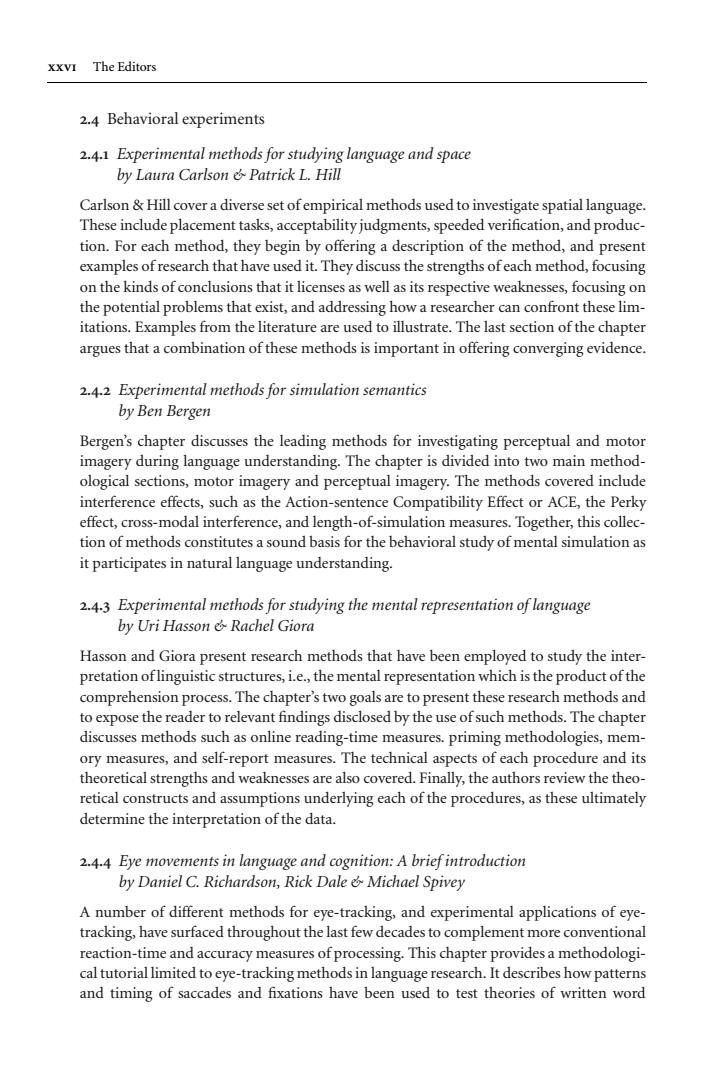正在加载图片...

xxVI The Editors 2.4 Behavioral experiments 2.4.1 Experimental methods for studying language and space by Laura Carlson e Patrick L.Hill Carlson&Hill cover a diverse set of empirical methods used to investigate spatial language. These include placement tasks,acceptability judgments,speeded verification,and produc- tion.For each method,they begin by offering a description of the method,and present examples of research that have used it.They discuss the strengths ofeach method,focusing on the kinds of conclusions that it licenses as well as its respective weaknesses,focusing on the potential problems that exist,and addressing how a researcher can confront these lim- itations.Examples from the literature are used to illustrate.The last section of the chapter argues that a combination of these methods is important in offering converging evidence. 2.4.2 Experimental methods for simulation semantics by Ben Bergen Bergen's chapter discusses the leading methods for investigating perceptual and motor imagery during language understanding.The chapter is divided into two main method- ological sections,motor imagery and perceptual imagery.The methods covered include interference effects,such as the Action-sentence Compatibility Effect or ACE,the Perky effect,cross-modal interference,and length-of-simulation measures.Together,this collec- tion of methods constitutes a sound basis for the behavioral study of mental simulation as it participates in natural language understanding. 2.4.3 Experimental methods for studying the mental representation of language by Uri Hasson e Rachel Giora Hasson and Giora present research methods that have been employed to study the inter- pretation oflinguistic structures,i.e.,the mental representation which is the product of the comprehension process.The chapter's two goals are to present these research methods and to expose the reader to relevant findings disclosed by the use of such methods.The chapter discusses methods such as online reading-time measures.priming methodologies,mem- ory measures,and self-report measures.The technical aspects of each procedure and its theoretical strengths and weaknesses are also covered.Finally,the authors review the theo- retical constructs and assumptions underlying each of the procedures,as these ultimately determine the interpretation of the data. 2.4.4 Eye movements in language and cognition:A brief introduction by Daniel C.Richardson,Rick Dale Michael Spivey A number of different methods for eye-tracking,and experimental applications of eye- tracking,have surfaced throughout the last few decades to complement more conventional reaction-time and accuracy measures of processing.This chapter provides a methodologi- cal tutorial limited to eye-tracking methods in language research.It describes how patterns and timing of saccades and fixations have been used to test theories of written wordJB[v.20020404] Prn:12/04/2007; 9:53 F: HCP18IN.tex / p.5 (317-372) The Editors . Behavioral experiments .. Experimental methods for studying language and space by Laura Carlson & Patrick L. Hill Carlson & Hill cover a diverse set of empirical methods used to investigate spatial language. These include placement tasks, acceptability judgments, speeded verification, and production. For each method, they begin by offering a description of the method, and present examples of research that have used it. They discuss the strengths of each method, focusing on the kinds of conclusions that it licenses as well as its respective weaknesses, focusing on the potential problems that exist, and addressing how a researcher can confront these limitations. Examples from the literature are used to illustrate. The last section of the chapter argues that a combination of these methods is important in offering converging evidence. .. Experimental methods for simulation semantics by Ben Bergen Bergen’s chapter discusses the leading methods for investigating perceptual and motor imagery during language understanding. The chapter is divided into two main methodological sections, motor imagery and perceptual imagery. The methods covered include interference effects, such as the Action-sentence Compatibility Effect or ACE, the Perky effect, cross-modal interference, and length-of-simulation measures. Together, this collection of methods constitutes a sound basis for the behavioral study of mental simulation as it participates in natural language understanding. .. Experimental methods for studying the mental representation of language by Uri Hasson & Rachel Giora Hasson and Giora present research methods that have been employed to study the interpretation of linguistic structures, i.e., the mental representation which is the product of the comprehension process. The chapter’s two goals are to present these research methods and to expose the reader to relevant findings disclosed by the use of such methods. The chapter discusses methods such as online reading-time measures. priming methodologies, memory measures, and self-report measures. The technical aspects of each procedure and its theoretical strengths and weaknesses are also covered. Finally, the authors review the theoretical constructs and assumptions underlying each of the procedures, as these ultimately determine the interpretation of the data. .. Eye movements in language and cognition: A brief introduction by Daniel C. Richardson, Rick Dale & Michael Spivey A number of different methods for eye-tracking, and experimental applications of eyetracking, have surfaced throughout the last few decades to complement more conventional reaction-time and accuracy measures of processing. This chapter provides a methodological tutorial limited to eye-tracking methods in language research. It describes how patterns and timing of saccades and fixations have been used to test theories of written word